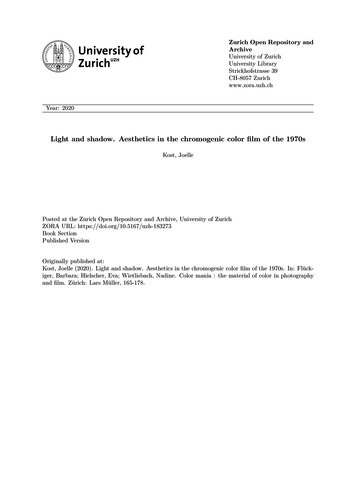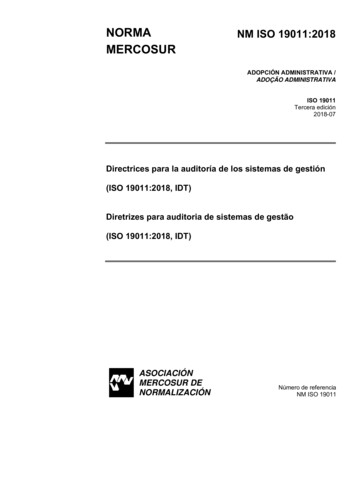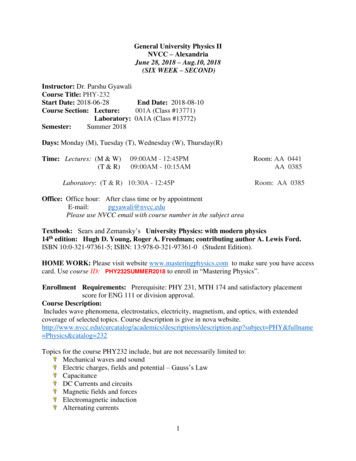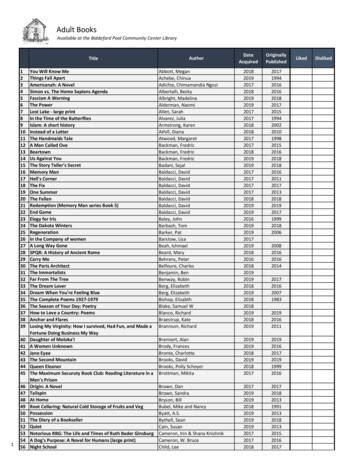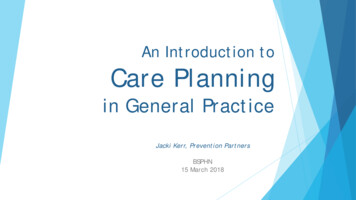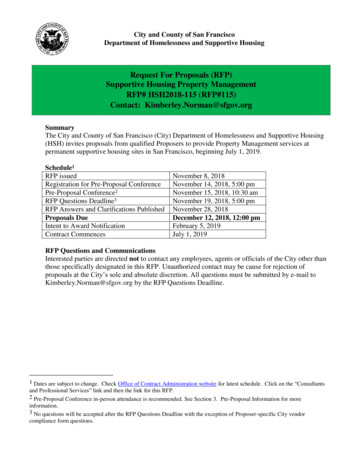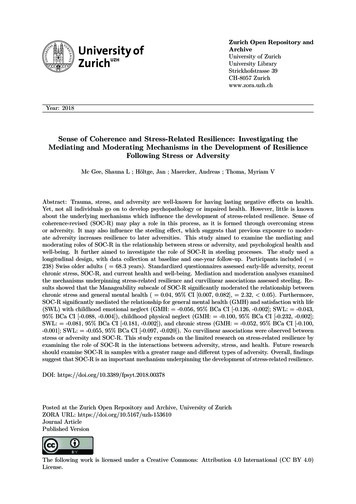
Transcription
Zurich Open Repository andArchiveUniversity of ZurichUniversity LibraryStrickhofstrasse 39CH-8057 Zurichwww.zora.uzh.chYear: 2018Sense of Coherence and Stress-Related Resilience: Investigating theMediating and Moderating Mechanisms in the Development of ResilienceFollowing Stress or AdversityMc Gee, Shauna L ; Höltge, Jan ; Maercker, Andreas ; Thoma, Myriam VAbstract: Trauma, stress, and adversity are well-known for having lasting negative effects on health.Yet, not all individuals go on to develop psychopathology or impaired health. However, little is knownabout the underlying mechanisms which influence the development of stress-related resilience. Sense ofcoherence-revised (SOC-R) may play a role in this process, as it is formed through overcoming stressor adversity. It may also influence the steeling effect, which suggests that previous exposure to moderate adversity increases resilience to later adversities. This study aimed to examine the mediating andmoderating roles of SOC-R in the relationship between stress or adversity, and psychological health andwell-being. It further aimed to investigate the role of SOC-R in steeling processes. The study used alongitudinal design, with data collection at baseline and one-year follow-up. Participants included ( 238) Swiss older adults ( 68.3 years). Standardized questionnaires assessed early-life adversity, recentchronic stress, SOC-R, and current health and well-being. Mediation and moderation analyses examinedthe mechanisms underpinning stress-related resilience and curvilinear associations assessed steeling. Results showed that the Manageability subscale of SOC-R significantly moderated the relationship betweenchronic stress and general mental health ( 0.04, 95% CI [0.007, 0.082], 2.32, 0.05). Furthermore,SOC-R significantly mediated the relationship for general mental health (GMH) and satisfaction with life(SWL) with childhood emotional neglect (GMH: -0.056, 95% BCa CI [-0.126, -0.002]; SWL: -0.043,95% BCa CI [-0.088, -0.004]), childhood physical neglect (GMH: -0.100, 95% BCa CI [-0.232, -0.002];SWL: -0.081, 95% BCa CI [-0.181, -0.002]), and chronic stress (GMH: -0.052, 95% BCa CI [-0.100,-0.001]; SWL: -0.055, 95% BCa CI [-0.097, -0.020]). No curvilinear associations were observed betweenstress or adversity and SOC-R. This study expands on the limited research on stress-related resilience byexamining the role of SOC-R in the interactions between adversity, stress, and health. Future researchshould examine SOC-R in samples with a greater range and different types of adversity. Overall, findingssuggest that SOC-R is an important mechanism underpinning the development of stress-related resilience.DOI: https://doi.org/10.3389/fpsyt.2018.00378Posted at the Zurich Open Repository and Archive, University of ZurichZORA URL: https://doi.org/10.5167/uzh-153610Journal ArticlePublished VersionThe following work is licensed under a Creative Commons: Attribution 4.0 International (CC BY 4.0)License.
Originally published at:Mc Gee, Shauna L; Höltge, Jan; Maercker, Andreas; Thoma, Myriam V (2018). Sense of Coherence andStress-Related Resilience: Investigating the Mediating and Moderating Mechanisms in the Developmentof Resilience Following Stress or Adversity. Frontiers in Psychiatry, 9:378.DOI: https://doi.org/10.3389/fpsyt.2018.003782
ORIGINAL RESEARCHpublished: 21 August 2018doi: 10.3389/fpsyt.2018.00378Sense of Coherence andStress-Related Resilience:Investigating the Mediating andModerating Mechanisms in theDevelopment of Resilience FollowingStress or AdversityShauna L. Mc Gee 1,2*, Jan Höltge 1,2 , Andreas Maercker 1,2 and Myriam V. Thoma 1,21Psychopathology and Clinical Intervention, Institute of Psychology, University of Zürich, Zurich, Switzerland, 2 UniversityResearch Priority Program ‘Dynamics of Healthy Aging’, University of Zürich, Zurich, SwitzerlandEdited by:Ulrich Schnyder,Universität Zürich, SwitzerlandReviewed by:Tom Sensky,Imperial College London,United KingdomRonny Westerman,Bundesinstitut fürBevölkerungsforschung, Germany*Correspondence:Shauna L. Mc Gees.mcgee@psychologie.uzh.chSpecialty section:This article was submitted toMood and Anxiety Disorders,a section of the journalFrontiers in PsychiatryReceived: 24 May 2018Accepted: 30 July 2018Published: 21 August 2018Citation:Mc Gee SL, Höltge J, Maercker A andThoma MV (2018) Sense ofCoherence and Stress-RelatedResilience: Investigating the Mediatingand Moderating Mechanisms in theDevelopment of Resilience FollowingStress or Adversity.Front. Psychiatry 9:378.doi: 10.3389/fpsyt.2018.00378Frontiers in Psychiatry www.frontiersin.orgBackground: Trauma, stress, and adversity are well-known for having lasting negativeeffects on health. Yet, not all individuals go on to develop psychopathology or impairedhealth. However, little is known about the underlying mechanisms which influence thedevelopment of stress-related resilience. Sense of coherence-revised (SOC-R) may playa role in this process, as it is formed through overcoming stress or adversity. It mayalso influence the steeling effect, which suggests that previous exposure to moderateadversity increases resilience to later adversities.Objectives: This study aimed to examine the mediating and moderating roles of SOC-Rin the relationship between stress or adversity, and psychological health and well-being.It further aimed to investigate the role of SOC-R in steeling processes.Methods: The study used a longitudinal design, with data collection at baseline andone-year follow-up. Participants included (N 238) Swiss older adults (Mage 68.3years). Standardized questionnaires assessed early-life adversity, recent chronic stress,SOC-R, and current health and well-being. Mediation and moderation analyses examinedthe mechanisms underpinning stress-related resilience and curvilinear associationsassessed steeling.Results: Results showed that the Manageability subscale of SOC-R significantlymoderated the relationship between chronic stress and general mental health (b 0.04,95% CI [0.007, 0.082], t 2.32, p 0.05). Furthermore, SOC-R significantlymediated the relationship for general mental health (GMH) and satisfaction with life(SWL) with childhood emotional neglect (GMH: b 0.056, 95% BCa CI [ 0.126, 0.002]; SWL: b 0.043, 95% BCa CI [ 0.088, 0.004]), childhood physicalneglect (GMH: b 0.100, 95% BCa CI [ 0.232, 0.002]; SWL: b 0.081,95% BCa CI [ 0.181, 0.002]), and chronic stress (GMH: b 0.052, 95%BCa CI [ 0.100, 0.001]; SWL: b 0.055, 95% BCa CI [ 0.097, 0.020]).No curvilinear associations were observed between stress or adversity and SOC-R.1August 2018 Volume 9 Article 378
Mc Gee et al.Underlying Mechanisms of Stress-Related ResilienceConclusions: This study expands on the limited research on stress-related resilienceby examining the role of SOC-R in the interactions between adversity, stress, and health.Future research should examine SOC-R in samples with a greater range and differenttypes of adversity. Overall, findings suggest that SOC-R is an important mechanismunderpinning the development of stress-related resilience.Keywords: sense of coherence-revised, stress-related resilience, resilience mechanisms, psychological health,mediating factorINTRODUCTIONdeveloped mental health disorders in later life: 23% majordepressive disorder, 26.3% posttraumatic stress disorder, and7.8% generalized anxiety disorder (13, 14). Nevertheless, despitethe experiences of early-life trauma and adversity, results showedthat many former Verdingkinder had no mental health disordersand some also showed indications of resilience in later life (15).Despite the increasing research interest on resilience in theaftermath of stress or adversity, there is a lack of informationon the underlying mechanisms which influence the developmentof this stress-related resilience. The interplay between risk andresilience factors needs to be further explored in order to betterunderstand resilience processes and interindividual differencesin psychological health and well-being. One factor which mayplay an important role in the development of stress-relatedresilience is the recently revised Sense of Coherence (SOCR) concept. The SOC-R concept and scale was developed byBachem and Maercker (16) as a revision of the original Senseof Coherence (SOC), which had shown conflicting results withregard to its psychometric properties (17–19). The original SOCrefers to a way of viewing the world which facilitates successfulcoping with stressors and is comprised of three components:(1) Comprehensibility, that stimuli are perceived as structured,predictable, and explicable; (2) Manageability, that adequateresources are available to meet demands; and (3) Meaningfulness,that demands are viewed as worth investing in and engagingwith (20, 21). While the revised SOC-R concept builds onAntonovsky’s research, it assumes a more neutral position on thepredictability of events and instead focuses on dealing with theambiguity of life experiences (16).SOC-R refers to an individual’s ability to integrate and balanceboth positive and negative experiences in order to maintain anddevelop health and well-being (16). This ability is proposed todevelop through the successful coping with and overcomingof experiences of stress or adversity (21). It may thereforebe considered an indicator of stress-related resilience aspects.Similar to the original SOC, the SOC-R concept and scale iscomprised of three theoretical dimensions and also includesthe manageability dimension: (1) Manageability, the ability tocome to terms and deal with difficult situations. However, twonew dimensions were developed to reflect the revised concept:(2) Reflection, the ability to consider different perspectives andunderstand connections, and (3) Balance, the ability to balancepositive and negative experiences and feelings (16). Regardingthe theoretical assumptions of SOC-R, it is suggested thatthrough these three aspects of SOC-R, individuals are able tomobilize available and appropriate resources in order to copeTrauma, adversity, and stress exposure can have lasting negativeeffects on psychological health and well-being. In particular,early-life adversity (such as trauma, maltreatment, or neglect)has been shown to lead to long-term health-related problemsand the development of mental health disorders (1, 2). Forinstance, a large-scale study by the World Health Organization(WHO) examined the prevalence of mental health disordersacross 21 countries. Findings revealed that 38.8% of participantshad experienced some form of early-life adversity, such asmaltreatment and neglect, family violence, or physical abuse.It further revealed that such experiences of early-life adversityaccounted for 29.8% of psychological disorders in adulthood(3). In addition, stress exposure is also associated with longterm negative outcomes, with chronic stress in particular beingdetrimental to health. Continuous or repeated exposure to stresscan result in cumulative adverse effects on physiological health(4, 5). This “wear and tear” on the body has been shown to leadto an increased susceptibility to the development of stress-relatedmental health problems, such as depression, anxiety, and posttraumatic stress disorder (6, 7). However, while stress or adversitycan lead to long-term negative outcomes, not all individualsgo on to develop psychopathology or impaired physicalhealth.Many individuals are able to adapt to stress or adversityand maintain good health and quality of life (8, 9). Suchheterogeneity in response to stress or adversity can be explainedby the concept of “resilience.” Resilience refers to the abilityto adapt to experiences of stress or adversity and maintain astable trajectory of healthy psychosocial and physical functioning(10). For example, with regard to chronic stress, a study bySharpley et al. (11) examined the relationship between chronicstress, resilience, and depression in 104 cancer patients. Resultsindicated that at low to moderate levels of chronic stress,individuals showed higher levels of resilience and lower levelsof depression. In relation to early-life adversity, one notableexample of longer-term outcomes of trauma and adversity isthe recent longitudinal project by Maercker and colleagues. Thisresearch examined psychopathological and resilient outcomesin an adult sample of former indentured child laborers inSwitzerland (i.e., the so-called Verdingkinder). Many formerVerdingkinder experienced high levels of exposure to traumaand maltreatment in childhood, including physical, emotional,and sexual abuse, as well as physical and emotional neglect(1, 12). Findings showed that some former Verdingkinder hadFrontiers in Psychiatry www.frontiersin.org2August 2018 Volume 9 Article 378
Mc Gee et al.Underlying Mechanisms of Stress-Related Resiliencewith stressors and adversity. Furthermore, SOC-R is assumed tobe relatively stable later in life and a strong SOC-R is assumed tofacilitate healthy aging through the maintenance of psychologicalhealth and well-being (16, 22).Initial research with the SOC-R examined its role inovercoming minor adversities (in the form of daily hassles), aswell as major adversities (16). Participants included a bereavedsample (n 334) and a control sample from the generalpopulation (n 157). Results of this study indicated that SOCR may be a useful coping mechanism for both minor adversitiesand extreme stressors. This study also compared the originalSOC and SOC-R. With regard to total scores, lower SOC-Rwas observed in the bereaved sample in comparison to thegeneral population sample. These results were consistent withthe findings for the original SOC scale. In addition, constructvalidity was improved in the SOC-R scale, as SOC-R showedlower correlations than the original SOC with measures ofpsychological well-being, such as optimism, neuroticism, andself-efficacy (16). These initial findings suggested that the SOCR scale may be a suitable alternative to the original SOC scale.Further studies have examined the moderating role of SOCR on the association between adversity health outcomes. Onesuch study examined the influence of SOC-R on the relationshipbetween early-life adversity (in the form of emotional neglect)and mental health in later life (23). Results showed that SOCR significantly moderated this relationship and acted as a bufferagainst the negative effects of emotional neglect, with strongerSOC-R associated with better mental health. A more recentstudy also investigated the interaction between SOC-R and valueorientations in predicting posttraumatic growth in bereavedparents (24). Results found a significant interaction betweenSOC-R and the value self-transcendence, with stronger SOC-Rassociated with higher levels of posttraumatic growth.The above research suggests that the strength of an individual’sSOC-R can influence their ability to cope with stress or adversity,with stronger SOC-R associated with better outcomes. However,thus far no research exists on the potential mediating role ofSOC-R. Previous research with the original SOC construct hasshown that SOC can mediate the relationship between adversityand health. For instance, a study with N 193 participantsfrom the general population found that the relationship betweenadversity (as indicated by worry, anxiety, and stress) andpsychological well-being (as indicated by satisfaction with life)was best explained through the significant mediation of SOC(25). Additionally, a more recent longitudinal study examinedthe mediating role of SOC in N 162 cancer patients.Results showed that following a diagnosis of breast cancer, SOCsignificantly mediated the change in health-related quality of lifeover a 6-month period, as indicated by factors such as globalquality of life and cognitive, social, and emotional functioning(26). Based on these findings, it is anticipated that SOC-R wouldalso act as a mediator between stress or adversity and indicatorsof psychological health and well-being. However, the mediatingrole of SOC-R remains unclear and further research is needed inthis area.Furthermore, as the development of SOC-R is closely linked tothe experiences of stress or adversity, the strength and influenceFrontiers in Psychiatry www.frontiersin.orgof SOC-R may therefore differ depending on the type and severityof the adversity, as well as the stage in the lifespan at which itoccurs (23, 27). The majority of the research on SOC-R to-datehas focused on early-life adversity and event-specific adversity(e.g., bereavement). Research is therefore needed to examine therole of SOC-R with different types and severities of adversity.Related to severity is the concept of “steeling.” The steelingeffect suggests that previous exposure to some or moderateamounts of stress or adversity can strengthen an individualby increasing their resilience and resistance to later stress(28). In comparison, extreme stress or adversity may be toooverwhelming to facilitate successful coping, and minimal stressor adversity may not be sufficiently challenging to necessitatethe development of coping abilities. Moderate stress or adversityis therefore proposed to be more beneficial than extreme oreven minimal stress or adversity (28, 29). Thus, in accordancewith the steeling effect, a non-linear, quadratic (i.e., U-shaped)relationship should exist between stress or adversity and wellbeing (29). Studies have therefore focused on testing the steelingeffect theory by assessing curvilinear (i.e., non-linear) ratherthan linear models of adversity. Results have demonstratedcurvilinear relationships between different types of stress oradversity and indicators of health and well-being. For example,some studies have shown optimal health outcomes at moderatelevels of early-life adversity [e.g., (30)], lifetime adversity [e.g.,(31)], and perceived stress [e.g., (32)]. In addition, a recentstudy examined the underlying factors involved in steelingby investigating the relationship between early-life adversity,mental health, and successful aging (33). Findings supported thesteeling effect and showed optimal levels of successful aging atmoderate levels of early-life adversity and that mental healthwas a significant mediator of this relationship. These studiesprovide initial evidence for a steeling effect. However, it is arelatively new and emerging area of resilience research and littleis known about the underlying mechanisms which may influencethe steeling effect. Given the function of SOC-R in overcomingstress or adversity, it may also play a role in steeling processes.Further research is required to clarify the role of SOC-R in thedevelopment of stress-related resilience and, in turn, its influenceon health and well-being.Therefore, to address the gaps identified in the literature, themain aim of the current study was to examine the potentialmediating and moderating roles of SOC-R in the relationshipbetween stress or adversity and indicators of psychological healthand well-being. As recommended by Fossion et al. (27) and McGee et al. (23), and to build on the existing research with SOCR, the current study assessed two types of stress or adversity,occurring at different stages in the lifespan: early-life adversity(i.e., childhood trauma and maltreatment) and recent chronicstress. Related to this main aim, two hypotheses were tested:First, based on the theoretical assumptions of SOC-R and theexisting empirical evidence, it was hypothesized that SOC-Rwould significantly moderate the relationship between stressor adversity and indicators of psychological health and wellbeing (i.e., general mental health, satisfaction with life). It wasexpected that individuals with a strong SOC-R would show betterpsychological health than individuals with weaker SOC-R, even3August 2018 Volume 9 Article 378
Mc Gee et al.Underlying Mechanisms of Stress-Related Resilienceα 0.54 and 0.77 for the subscales (16, 23). The SOC-R scalehas also been shown to have high test-retest reliability, with anr 0.85 over a 1-month period, and r 0.74 over an interval of15 months (16).with high levels of stress or adversity. Second, it was hypothesizedthat SOC-R would significantly mediate the relationship betweenstress or adversity and indicators of psychological health andwell-being (i.e., general mental health, satisfaction with life).Finally, an additional aim of this study was to conduct anexploratory analysis to investigate the steeling effect and therole of SOC-R in steeling processes. It was therefore expectedthat moderate levels of stress or adversity would be associatedwith stronger SOC-R, which in turn would lead to optimalpsychological health and well-being (i.e., general mental health,satisfaction with life).Childhood Trauma Questionnaire [CTQ; (37)]The CTQ measures trauma and adversity experienced early inlife. It is comprised of 28 items rated on a five-point Likertscale. It is composed of the following five subscales, with eachsubscale assessed by 5 items: emotional abuse, physical abuse,sexual abuse, emotional neglect, and physical neglect. It alsoincludes a three-item minimization-denial scale to detect falsenegative trauma reports. The German version shows sufficientinternal consistency across all subscales, with a Cronbach’s alphaof between α 0.55 and 0.96 (38, 39).MATERIALS AND METHODSStudy Design and ProcedureThe current study was part of an overarching, longitudinalresearch project on the steeling effect (“Healthy Aging Againstthe Odds—Mechanisms behind the Steeling Effect”). Aquantitative survey composed of standardized questionnaireswas used in this study to assess positive and negative experiences,stress or adversity, current health and well-being, and resiliencerelated resources. The study was organized and conducted inthe University of Zurich and was conducted with the informedconsent of all participants in accordance with the Declarationof Helsinki. The protocol was approved by the Swiss ethicscommittee of the Canton of Zurich (ID 2015-00135) and theEthics Committee of the Faculty of Arts and Social Sciences inthe University of Zurich, Switzerland.Screening Scale of Chronic Stress [SSCS; (40)]The SSCS is a screening subscale of the Trier Inventory for theAssessment of Chronic Stress (TICS) and measures perceivedstress over the previous 3-month period. It assesses five domainsof stress: chronic worrying, work-related overload, socialoverload, excessive demands, and lack of social recognition.It consists of 12 items rated on a five-point Likert scale andyields a single score. The German version shows high internalconsistency of α 0.87 (41).36-Item Short Form Health Survey Version 2 [SF-36V2; (42, 43)]The SF-36 measures current mental and physical health. Itconsists of 36 items and is comprised of eight subscales whichcombine to form the two distinct component summary scoresfor mental and physical health. The physical component consistsof four subscales: physical functioning, role-physical, bodilypain, and general health; and the mental component consists offour subscales: vitality, social functioning, role-emotional, andmental health (43). To calculate the component summary scores,population- and gender-specific norms for means, standarddeviations, and factors loadings are used. As country-specificnorms are currently unavailable for Switzerland, German normswere used in the current study (44, 45). The mental healthcomponent was used in the current study as an indicator ofpsychological health. The German version shows high internalconsistency across the eight subscales, with a Cronbach’s alpha ofbetween α 0.81 and 0.94 (43).ParticipantsEligible participants were those who met the following inclusioncriteria: adults aged 50 years or older, and native Swiss-Germanspeakers. G Power software was initially used to calculatethe statistical power analysis. In addition, empirical researchrecommendations for mediation and moderation analyses werealso taken into consideration in determining the required samplesize. A minimum sample of N 224 was required in order todetect small to medium effect sizes, with a significance level ofp 0.05, and statistical power (1-β) of 0.80 (34–36).MeasuresSense of Coherence Scale—Revised [SOC-R; (16)]The SOC-R scale assesses an individual’s ability to perceive andintegrate both positive and negative life experiences in orderto maintain and develop health (16). As SOC-R is assumed todevelop within the context of adversity, it was used in the currentstudy as an indicator of a stress-related resilience resource. TheSOC-R scale is comprised of 13 items rated on a five-pointLikert scale and yields a single score. The three dimensions whichcomprise the scale are: Manageability (e.g., “One can always finda way to cope with painful things in life”), Balance (e.g., “In mythoughts and actions I take into account that things often havetwo sides: good and bad ones”), and Reflection (e.g., “Normally Ican consider a situation from various perspectives”). It is availablein German and English, and results from the German versionshow high internal consistency of between α 0.75 and 0.81for the total scale, and sufficient internal consistency of betweenFrontiers in Psychiatry www.frontiersin.orgSatisfaction With Life Scale [SWLS; (46)]The SWLS measures subjective well-being in relation to globallife satisfaction (47). It consists of five items rated on a sevenpoint Likert scale and yields a single score. The German versionshows high internal consistency of α 0.92 (48).ProcedureA longitudinal study was conducted in the German-speakingregions of Switzerland. The study consisted of two assessmenttime points: baseline assessment at T1 (summer 2016) and afollow-up assessment 12 months later at T2 (summer 2017).Study participants were recruited using advertisements onwebsites, in newspapers and magazines, posted flyers, and radio4August 2018 Volume 9 Article 378
Mc Gee et al.Underlying Mechanisms of Stress-Related Resiliencethe CTQ subscales. In order to examine the influence of morerecent stress, T2 variables were assessed with chronic stress as thepredictor.Mediation analyses (model 4) and moderation analyses(model 1) were conducted using the PROCESS version 3.0macro for SPSS (50). Socio-demographic variables (i.e., ageand education) which showed significant correlations with thepredictor and outcomes variables were included as covariates inthese analyses to control for potential confounding. Where effectswere not observed for total SOC-R, analyses were conductedwith the SOC-R subscale level in order to probe potentialunderlying effects from the dimensions which comprise andultimately influence SOC-R. Regarding the moderation analyses,a “regions of significance” analysis was also conducted usingthe Johnson-Neyman procedure (55). This procedure providesadditional information on the significance regions for the effectof the predictor (early-life adversity and chronic stress) on theoutcome (general mental health and satisfaction with life) atspecific values of a continuous moderator (SOC-R). In addition,in order to investigate the role of SOC-R in steeling processescurvilinear (i.e., non-linear) associations, specifically quadraticrelationships, must be assessed. To examine these potentialcurvilinear relationships, the linear stress and adversity termsmust first be controlled for by including these variables ascovariates in the model. The quadratic (i.e., squared) terms forearly-life adversity (CTQ2 ) and chronic stress (SSCS2 ) were thenimplemented into the mediation model (29, 56). Within thismodel, a steeling effect is indicated by a significant relationshipbetween the quadratic adversity and stress terms and themediator (i.e., SOC-R), and with the health and well-beingindicators of general mental health and satisfaction with life.interviews with the authors. Participants were also recruitedthrough the University Research Priority Program “Dynamicsof Healthy Aging” in the University of Zurich. The surveywas available as an online survey or in pen-and-paper format.Individuals who were interested in taking part contacted theresearch team and were either emailed a link to the onlinesurvey or were posted a pen-and-paper survey package. Astudy incentive was provided at each assessment point, withparticipants who completed the survey being entered into a rafflefor 10 shopping vouchers.The online survey was programmed using Uniparksoftware (49). After following the link to the online survey,participants were provided with the study information sheetand then the informed consent form. Participants providedinformed consent online by ticking the corresponding box toindicate their consent to participate in the study. Only if theyprovided informed consent could participants go on to completethe questionnaires. The pen-and-paper survey package alsocontained an information sheet, an informed consent form, andthe questionnaire survey, as well as a free-post return envelope.At T2, participants were provided with either the online surveylink or the pen-and-paper survey package depending on theirpreference at T1. Both survey formats were randomized at thescale level for each participant in order to avoid sequence andorder effects. All assessment instruments were repeated at T2,except for the CTQ. As the CTQ assessed trauma and adversityexperienced in childhood, this data was collected at baseline (T1)and the scale was then removed from the survey at T2 to reduceparticipant burden. Only data for which informed consent hadbeen provided was included in the dataset and analyses.Statistical AnalysisIBM Statistical Package for Social Sciences (SPSS) version 25.0and PROCESS version 3.0 macro for SPSS were used to analyzethe data (50, 51). For each instrument, less than 1% missingvalues were observed. Little’s missing completely at random(MCAR) test suggested that most of the values
and maltreatment in childhood, including physical, emotional, and sexual abuse, as well as physical and emotional neglect (1, 12). Findings showed that some former Verdingkinder had developed mental health disorders in later life: 23% major depressive disorder, 26.3% posttraumatic stress disorder, and 7.8% generalized anxiety disorder (13, 14).
